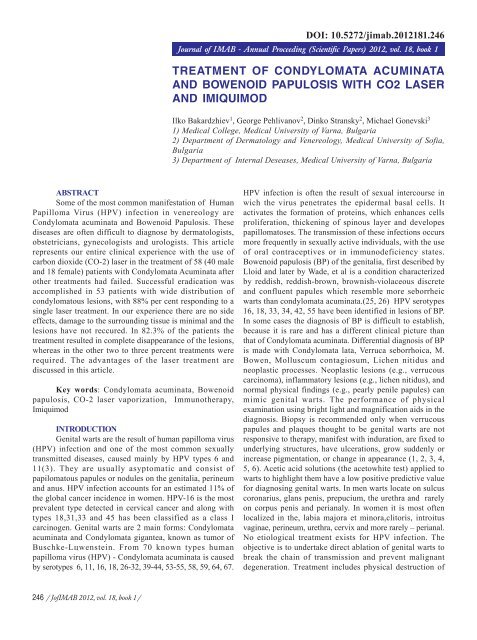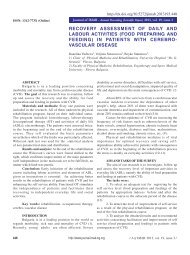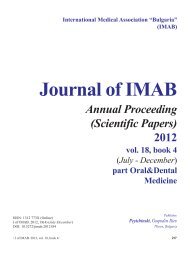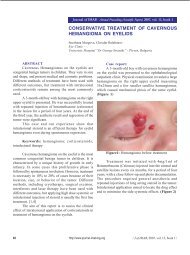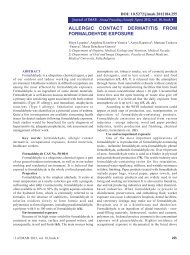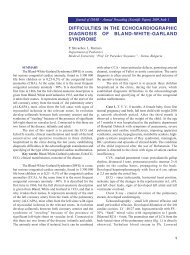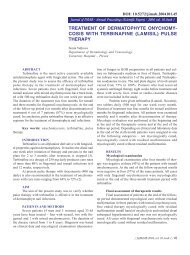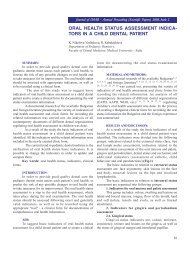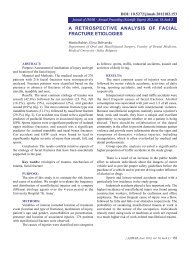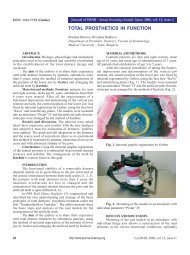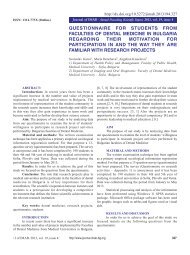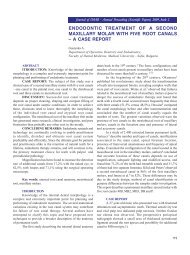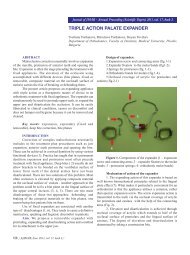treatment of condylomata acuminata and ... - Journal of IMAB
treatment of condylomata acuminata and ... - Journal of IMAB
treatment of condylomata acuminata and ... - Journal of IMAB
You also want an ePaper? Increase the reach of your titles
YUMPU automatically turns print PDFs into web optimized ePapers that Google loves.
DOI: 10.5272/jimab.2012181.246<br />
<strong>Journal</strong> <strong>of</strong> <strong>IMAB</strong> - Annual Proceeding (Scientific Papers) 2012, vol. 18, book 1<br />
TREATMENT OF CONDYLOMATA ACUMINATA<br />
AND BOWENOID PAPULOSIS WITH CO2 LASER<br />
AND IMIQUIMOD<br />
Ilko Bakardzhiev 1 , George Pehlivanov 2 , Dinko Stransky 2 , Michael Gonevski 3<br />
1) Medical College, Medical University <strong>of</strong> Varna, Bulgaria<br />
2) Department <strong>of</strong> Dermatology <strong>and</strong> Venereology, Medical University <strong>of</strong> S<strong>of</strong>ia,<br />
Bulgaria<br />
3) Department <strong>of</strong> Internal Deseases, Medical University <strong>of</strong> Varna, Bulgaria<br />
ABSTRACT<br />
Some <strong>of</strong> the most common manifestation <strong>of</strong> Human<br />
Papilloma Virus (HPV) infection in venereology are<br />
Condylomata <strong>acuminata</strong> <strong>and</strong> Bowenoid Papulosis. These<br />
diseases are <strong>of</strong>ten difficult to diagnose by dermatologists,<br />
obstetricians, gynecologists <strong>and</strong> urologists. This article<br />
represents our entire clinical experience with the use <strong>of</strong><br />
carbon dioxide (CO-2) laser in the <strong>treatment</strong> <strong>of</strong> 58 (40 male<br />
<strong>and</strong> 18 female) patients with Condylomata Acuminata after<br />
other <strong>treatment</strong>s had failed. Successful eradication was<br />
accomplished in 53 patients with wide distribution <strong>of</strong><br />
condylomatous lesions, with 88% per cent responding to a<br />
single laser <strong>treatment</strong>. In our experience there are no side<br />
effects, damage to the surrounding tissue is minimal <strong>and</strong> the<br />
lesions have not reccured. In 82.3% <strong>of</strong> the patients the<br />
<strong>treatment</strong> resulted in complete disappearance <strong>of</strong> the lesions,<br />
whereas in the other two to three percent <strong>treatment</strong>s were<br />
required. The advantages <strong>of</strong> the laser <strong>treatment</strong> are<br />
discussed in this article.<br />
Key words: Condylomata <strong>acuminata</strong>, Bowenoid<br />
papulosis, CO-2 laser vaporization, Immunotherapy,<br />
Imiquimod<br />
INTRODUCTION<br />
Genital warts are the result <strong>of</strong> human papilloma virus<br />
(HPV) infection <strong>and</strong> one <strong>of</strong> the most common sexually<br />
transmitted diseases, caused mainly by HPV types 6 <strong>and</strong><br />
11(3). They are usually asyptomatic <strong>and</strong> consist <strong>of</strong><br />
papilomatous papules or nodules on the genitalia, perineum<br />
<strong>and</strong> anus. HPV infection accounts for an estimated 11% <strong>of</strong><br />
the global cancer incidence in women. HPV-16 is the most<br />
prevalent type detected in cervical cancer <strong>and</strong> along with<br />
types 18,31,33 <strong>and</strong> 45 has been classified as a class I<br />
carcinogen. Genital warts are 2 main forms: Condylomata<br />
<strong>acuminata</strong> <strong>and</strong> Condylomata gigantea, known as tumor <strong>of</strong><br />
Buschke-Löwenstein. From 70 known types human<br />
papilloma virus (HPV) - Condylomata <strong>acuminata</strong> is caused<br />
by serotypes 6, 11, 16, 18, 26-32, 39-44, 53-55, 58, 59, 64, 67.<br />
HPV infection is <strong>of</strong>ten the result <strong>of</strong> sexual intercourse in<br />
wich the virus penetrates the epidermal basal cells. It<br />
activates the formation <strong>of</strong> proteins, which enhances cells<br />
proliferation, thickening <strong>of</strong> spinous layer <strong>and</strong> developes<br />
papillomatoses. The transmission <strong>of</strong> these infections occurs<br />
more frequently in sexually active individuals, with the use<br />
<strong>of</strong> oral contraceptives or in immunodeficiency states.<br />
Bowenoid papulosis (BP) <strong>of</strong> the genitalia, first described by<br />
Lloid <strong>and</strong> later by Wade, et al is a condition characterized<br />
by reddish, reddish-brown, brownish-violaceous discrete<br />
<strong>and</strong> confluent papules which resemble more seborrheic<br />
warts than <strong>condylomata</strong> <strong>acuminata</strong>.(25, 26) HPV serotypes<br />
16, 18, 33, 34, 42, 55 have been identified in lesions <strong>of</strong> BP.<br />
In some cases the diagnosis <strong>of</strong> BP is difficult to establish,<br />
because it is rare <strong>and</strong> has a different clinical picture than<br />
that <strong>of</strong> Condylomata <strong>acuminata</strong>. Differential diagnosis <strong>of</strong> BP<br />
is made with Condylomata lata, Verruca seborrhoica, M.<br />
Bowen, Molluscum contagiosum, Lichen nitidus <strong>and</strong><br />
neoplastic processes. Neoplastic lesions (e.g., verrucous<br />
carcinoma), inflammatory lesions (e.g., lichen nitidus), <strong>and</strong><br />
normal physical findings (e.g., pearly penile papules) can<br />
mimic genital warts. The performance <strong>of</strong> physical<br />
examination using bright light <strong>and</strong> magnification aids in the<br />
diagnosis. Biopsy is recommended only when verrucous<br />
papules <strong>and</strong> plaques thought to be genital warts are not<br />
responsive to therapy, manifest with induration, are fixed to<br />
underlying structures, have ulcerations, grow suddenly or<br />
increase pigmentation, or change in appearance (1, 2, 3, 4,<br />
5, 6). Acetic acid solutions (the acetowhite test) applied to<br />
warts to highlight them have a low positive predictive value<br />
for diagnosing genital warts. In men warts locate on sulcus<br />
coronarius, glans penis, prepucium, the urethra <strong>and</strong> rarely<br />
on corpus penis <strong>and</strong> perianaly. In women it is most <strong>of</strong>ten<br />
localized in the, labia majora et minora,clitoris, introitus<br />
vaginae, perineum, urethra, cervix <strong>and</strong> more rarely – perianal.<br />
No etiological <strong>treatment</strong> exists for HPV infection. The<br />
objective is to undertake direct ablation <strong>of</strong> genital warts to<br />
break the chain <strong>of</strong> transmission <strong>and</strong> prevent malignant<br />
degeneration. Treatment includes physical destruction <strong>of</strong><br />
246 / J<strong>of</strong><strong>IMAB</strong> 2012, vol. 18, book 1 /
lesions, medical <strong>treatment</strong> <strong>and</strong>/or immunotherapy. The<br />
numerous medical, physical <strong>and</strong> destructive regimen used<br />
in the <strong>treatment</strong> <strong>of</strong> <strong>condylomata</strong> <strong>acuminata</strong> include topical<br />
therapy (cryotherapy, Podophyllin, 5-fluouracil, Imiquimod,<br />
á- interferon), electrocoagulation, surgical <strong>and</strong> CO2 lazer<br />
vaporization, sometimes combining two or more <strong>of</strong> these<br />
approaches (23,24). Our purpose is to report here our<br />
experience with <strong>treatment</strong> <strong>of</strong> different clinical cases <strong>of</strong><br />
<strong>condylomata</strong> <strong>acuminata</strong> with CO-2 laser <strong>and</strong> Imiquimod. The<br />
topical immunostimulatory drug Imiquimod is<br />
imidazoquinolines <strong>and</strong> acts by stimulating toll-like<br />
receptors (TLR-7) thereby stimulating the innate immunity,<br />
i.e. giving a danger signal to the cells, which then start the<br />
production <strong>of</strong> pro-inflammatory cytokines like IFN-á, TNFá,<br />
IL-1,6,8 <strong>and</strong> 12 (22). Laser therapy is the most practical,<br />
innovateve <strong>treatment</strong> modality to come along in the last 10<br />
years. The CO 2 laser utilizes focuses infrared light energy<br />
to vaporize affected tissues. Carefully applied, CO-2 laser<br />
therapy directed at a field <strong>of</strong> <strong>treatment</strong> rather than a single<br />
spot, can yeld cure rates <strong>of</strong> up to 95% for grossly visible<br />
lesions(9,14,19). Carbon dioxide laser is particulary useful<br />
for lesions which are recalcitrant to other types <strong>of</strong><br />
therapy(17). It permits precise tissue ablation by spatial<br />
confinement <strong>of</strong> thermal damage <strong>and</strong> effective vaporization,<br />
which promotes rapid healing without scar formation in most<br />
cases. CO-2 laser therapy is a useful <strong>treatment</strong> modality,<br />
especially for extensive warts(16). HPV DNA may be released<br />
during laser vaporization <strong>of</strong> genital HPV infections; if<br />
appropriate evacuating equipment is used, contamination <strong>of</strong><br />
the operator is unlikely(8, 9,13). The surgeon <strong>and</strong> assisting<br />
personnel must wear laser masks <strong>and</strong> use a vacuum<br />
ventilation system (10). Newer studies are either poorly<br />
designed or involve too small a sample size. Most studies<br />
require additional therapies (10,11,13).<br />
PATIENTS AND METHODS<br />
From 2010, to 2011, 40 male <strong>and</strong> 18 female patients<br />
within the age range <strong>of</strong> between fifteen <strong>and</strong> fifty-five years<br />
were treated. CO-2 laser <strong>treatment</strong> was done localy to these<br />
58 patients, after infiltration <strong>of</strong> 1% lidocaine (Xylocaine). A<br />
Multi Function Fractional CO2 Laser System (Multixel),<br />
continuous wave mode, super dream pulse mode, with an<br />
optical spot size <strong>of</strong> 2.0 mm was used. The average power<br />
required varied from 3 to 6 watts for lesions measuring 0.2<br />
to 0.8 mm in diameter. After the operation the patients were<br />
advised to treat the operative field twice a day for 15 days<br />
with Braunol (solution) <strong>and</strong> Braunovidon (ungv). The<br />
perianal postoperative wounds were treated additionally<br />
with an antibiotic spray. All patients were seen for an<br />
examination for a first time 15 days after the operation. After<br />
that the patients continue to use local antiseptic <strong>and</strong><br />
epithelium creams for up to 30 days after the operation. All<br />
patients were receiving immunostimulant therapy for 2-3<br />
months – Biozin – 2x1 tabs. daily for 30 days or Isoprinosine<br />
3x2 tabs. for 30 days. During the period between 2009 <strong>and</strong><br />
2011 a group <strong>of</strong> 35 patients, consisting <strong>of</strong> men between the<br />
ages <strong>of</strong> 17 <strong>and</strong> 48 years, were treated with Imiquimod 5% -<br />
crème. Imiquimod was used to treat the lesion twice a week.<br />
The patients were advised to use Braunovidon ungv on the<br />
days when they were not applying Imiquimod 5% - crème.<br />
They were seen for a <strong>treatment</strong> evaluation after the first,<br />
second <strong>and</strong> third month since the beginning <strong>of</strong> the<br />
<strong>treatment</strong>.<br />
RESULTS<br />
1. Patients treated with CO2 laser: All patients were<br />
followed at three-month intervals for at least six months, <strong>and</strong><br />
advised to return if any occurrence was noted. The first<br />
<strong>treatment</strong> evaluation was performed 15 days after the<br />
operation. Average follow-up ranged from two to thirty<br />
months. Out <strong>of</strong> the 58 new cases <strong>of</strong> condyomatous lesions,<br />
55 patients (95%) responded to a single laser <strong>treatment</strong>.<br />
There were no recurrences in this group <strong>of</strong> patients 3 months<br />
after the operation. We have observed partial recurrence in<br />
3 patients, which required repeated <strong>treatment</strong> with the CO2<br />
laser. 2. Patients treated with Imiquimod 5%- crème: After<br />
the first month <strong>of</strong> local <strong>treatment</strong> with Imiquimod, we<br />
observed complete disappearance <strong>of</strong> the lesions in 22<br />
patients. (62.86%) After the second month we observed<br />
complete recovery in another 5 patients with the total number<br />
<strong>of</strong> complete recovery reaching 27 patients (77.1%).<br />
DISCUSIONS<br />
The sexual nature <strong>of</strong> transmission is well known, but<br />
there is also evidence <strong>of</strong> vertical <strong>and</strong> transmission through<br />
non-genital contact. (1). Nowadays the association <strong>of</strong> certain<br />
types <strong>of</strong> HPV with cervical cancer <strong>and</strong> an increased risk <strong>of</strong><br />
malignancy is well documented. Bowenoid papulosis is a<br />
pre-malignant condition affecting the ano-genital area, <strong>and</strong><br />
has been associated with high risk HPV genotypes. This<br />
disease should be considered in patients presenting to a<br />
Sexual health clinic with an atypical appearance <strong>of</strong> anogenital<br />
rash or warts. In atypical cases the diagnosis should<br />
be confirmed histologically. Treatment <strong>of</strong> genital warts <strong>and</strong><br />
Bowenoid papulosis usually involves locally destructive or<br />
ablative therapies such as excisional surgery,<br />
electrocoagulation, cryotherapy, 5- fluorouracil <strong>and</strong> laser<br />
therapy. Ricart et al. reported successful clearance <strong>of</strong> 90%<br />
<strong>of</strong> the lesions using Imiquimod cream 5% once a day for 3<br />
months. (6) A well tolerated <strong>and</strong> effective <strong>treatment</strong>, topical<br />
Imiquimod would appear to be a suitable alternative in cases<br />
<strong>of</strong> extensive or widespread ano-genital warts <strong>and</strong> Bowenoid<br />
Papulosis. It is difficult, if not impossible, to predict in<br />
which patients the <strong>treatment</strong> will be successful. (2, 7) Yan J,<br />
Chen S et al reported that imiquimod 5% cream <strong>and</strong><br />
podophyllotoxin 0.5% solution have an identical beneficial<br />
effect on anogenital warts <strong>and</strong> are associated with identical<br />
<strong>and</strong> acceptable side effect. Both substances constitute<br />
/ J<strong>of</strong><strong>IMAB</strong> 2012, vol. 18, book 1 / 247
effective <strong>and</strong> safe <strong>treatment</strong>s <strong>of</strong> untreated anogenital warts<br />
in immunocompetent individuals. (21) Carrozza et al.<br />
compared extensive genital warts in HIV-positive <strong>and</strong> HIVnegative<br />
patients. The clearance <strong>and</strong> recurrence rates were<br />
similar for both groups .(12,13) Local skin reactions such<br />
as erythema, erosion, excoriation, flaking <strong>and</strong> oedema are<br />
common after <strong>treatment</strong> with Imiquimod. Other local<br />
reactions such as induration, ulceration, scabbing, <strong>and</strong><br />
vesicles have also been reported. Should an intolerable skin<br />
reaction occur, the cream should be removed by washing<br />
the area with mild soap <strong>and</strong> water. Treatment with imiquimod<br />
cream can be resumed after the skin reaction has<br />
moderated.(23, 24) The risk <strong>of</strong> severe local skin reactions<br />
may be increased when imiquimod is used at higher than<br />
recommended doses. However, in rare cases severe local<br />
reactions that have required <strong>treatment</strong> <strong>and</strong>/or caused<br />
temporary incapacitation have been observed in patients<br />
who have used imiquimod according to the instructions.<br />
Imiquimod cream should be washed from the skin before<br />
sexual activity. The combined <strong>treatment</strong> with Braunowidon<br />
ungv, which we used with our patients treated with<br />
Imiquimod, lessened the inflammatory reaction <strong>and</strong><br />
enhanced the healing process. Imiquimod cream may<br />
weaken condoms <strong>and</strong> diaphragms, therefore concurrent use<br />
with imiquimod cream is not recommended. We recommend<br />
the <strong>treatment</strong> with Imiquimod as a method <strong>of</strong> choice for the<br />
flat type <strong>of</strong> Condylomata acuminatà, in which laser <strong>treatment</strong><br />
has a higher percentage <strong>of</strong> recurrences <strong>and</strong> postoperative<br />
complications <strong>and</strong> is much more difficult to perform. Local<br />
<strong>treatment</strong> with Imiquimod is a method <strong>of</strong> choice for patients<br />
who are scared <strong>of</strong> laser therapy <strong>and</strong> prefer to administer the<br />
<strong>treatment</strong> themselves despite the longer <strong>treatment</strong> period<br />
that is needed. The principal advantages <strong>of</strong> CO-2 laser<br />
therapy are precision (which results in sparing <strong>of</strong> normal<br />
tissue), probable elimination <strong>of</strong> the infective agent, <strong>and</strong><br />
relatively good cosmetic results. Carbon dioxide laser can<br />
be used to treat extensive <strong>and</strong> thick warts quickly <strong>and</strong><br />
without the drawing <strong>of</strong> blood. The carbon dioxide laser is<br />
able to effect such wart clearance in part because <strong>of</strong> the<br />
deeper penetration than the one which generally occurs with<br />
cryotherapy. The CO 2 laser is best used at power settings<br />
<strong>of</strong> 3-10 Watts because it vaporizes tissue with a shallow<br />
depth <strong>of</strong> penetration at those settings. However, laser<br />
<strong>treatment</strong> is more complex <strong>and</strong> costly than electrosurgery<br />
or cryotherapy.(8, 9, 11, 12) A disadvantage <strong>of</strong> the lasers is<br />
that the risk <strong>of</strong> scarring, although small, is greater than with<br />
cryotherapy. CO-2 laser therapy is typically an <strong>of</strong>fice<br />
procedure. However, larger lesions <strong>and</strong> pediatric patients<br />
may require anesthesia <strong>and</strong> therefore can be done in the<br />
hospital under general anesthesia.<br />
CONCLUSION<br />
Our results show that <strong>treatment</strong> with CO-2 – laser<br />
vaporization was the best <strong>treatment</strong> for condyloma <strong>of</strong> the<br />
anus, vulva <strong>and</strong> penis. Imiquimod seems an acceptable<br />
therapeutic alternative in cases <strong>of</strong> widespread ano-genital<br />
warts, as well as flat type Condylomatà <strong>acuminata</strong> located<br />
on the mucous membranes <strong>and</strong> the submucosa. Local<br />
<strong>treatment</strong> with Imiquimod is more effective in cases <strong>of</strong><br />
condylomas which are recent in nature or are <strong>of</strong> the flat type.<br />
The <strong>treatment</strong> with Imiquimod is preferred by patients who<br />
want to do it themselves <strong>and</strong> are comfortable to wait for a<br />
long period <strong>of</strong> time to achieve results. It is difficult to predict<br />
in which patient the <strong>treatment</strong> will be successful.<br />
Immunosuppression is one <strong>of</strong> the major risk factors for<br />
<strong>treatment</strong> failure (7). It can be concluded that this definite<br />
<strong>treatment</strong> method has been clearly found superior so far.<br />
Treatment should be guided by the available resources, the<br />
experience <strong>of</strong> the health provider <strong>and</strong> the preference <strong>of</strong> the<br />
patient. (5)<br />
REFERENCES:<br />
1. Elizabeth Lazaridou., Psyhological<br />
complications <strong>of</strong> genital warts. Fact <strong>and</strong><br />
fiction. Conferrence on Sexually<br />
transmitted infection, 7-9 October, 2004<br />
Isl<strong>and</strong> <strong>of</strong> Myconos, Greece., Book <strong>of</strong><br />
Abstract, 47<br />
2. Goorney BP, Polori R. A case <strong>of</strong><br />
Bowenoid papulosis <strong>of</strong> the penis<br />
successfully treated with topical<br />
aldara(Imiquimod) cream 5%, Conference<br />
on Sexually transmitted infection., 7-9<br />
October, 2004 Isl<strong>and</strong> <strong>of</strong> Myconos,Greece.,<br />
Book <strong>of</strong> Abstract, 209.<br />
3. Stone KM. Human papillomavirus<br />
infection <strong>and</strong> genital warts: update on<br />
epidemiology <strong>and</strong> <strong>treatment</strong>. Clin Infect<br />
Dis. 1995 Apr;20 (Suppl.1): S 91-97.<br />
[PubMed] [CrossRef]<br />
4. Beutner KR, Ferenczy A.<br />
Therapeutic approaches to genital warts.<br />
Am J Med. 1997 May 5;102(5A): 28-37.<br />
[PubMed]<br />
5. Skerlev M. Genital warts – <strong>treatment</strong><br />
<strong>and</strong> management. Abstracts <strong>of</strong> the 13th<br />
Congress <strong>of</strong> the European Academy <strong>of</strong><br />
Dermatology <strong>and</strong> Venereology, 17-21<br />
November 2004, Florence, Italy., J Eur<br />
Acad Dermatol Venereol. 2004 Nov;18<br />
Suppl 2,125. [PubMed]<br />
6. Ricart JM, Cordoba J, Hern<strong>and</strong>ez M,<br />
Esplugues I. Extensive genital bowenoid<br />
papulosis responding to imiquimod., J Eur<br />
Acad Dermatol Venereol. 2007<br />
Jan;21(1):113-115. [PubMed] [CrossRef]<br />
7. Van der Meiden W.I., Van,t H<strong>of</strong> A.T.<br />
One –year experience with imiquimod<br />
cream in the <strong>treatment</strong> <strong>of</strong> large or<br />
widespread ano-genital warts in patients<br />
seen at the Erasmus MC STD clinic.<br />
Abstracts <strong>of</strong> the 12 th Congress <strong>of</strong> the<br />
European Academy <strong>of</strong> Dermatology <strong>and</strong><br />
Venerology, 15-18 October 2003,<br />
Barcelona, Spain. EADV, vol.17 suppl.3,<br />
Nov 2003, 415<br />
8. Garden JM, O’Banion MK, Shelnitz<br />
LS, Pinski KS, Bakus AD, Reichmann ME,<br />
Sundberg JP. Papillomavirus in the vapor<br />
<strong>of</strong> carbon dioxide laser-treated verrucae.<br />
JAMA. 1988 Feb;259(8):1199-202.<br />
[PubMed]<br />
9. Ferenczy A, Behelak Y, Haber G,<br />
248 / J<strong>of</strong><strong>IMAB</strong> 2012, vol. 18, book 1 /
Wright TC Jr, Richart RM. Treating<br />
vaginal <strong>and</strong> external anogenital condyloma<br />
with electrosurgery vs CO-2 laser ablation.<br />
J Gynecol Surg. 1995 Spring;11(1):41-50.<br />
[PubMed]<br />
10. Petersen CS, Bjerring P, Larsen J,<br />
Blaakaer J, Hagdrup H, From E, Obergaard<br />
L. Systemic interferon alpha-2b increases<br />
the cure rate in laser treated patients with<br />
multiple persistent genital warts: aplacebocontrolled<br />
study. Genitourin Med. 1991<br />
Apr;67(2):99-102. [PubMed]<br />
11. Davis BE, Noble MJ: Initial<br />
experience with combined interferonalfa2b<br />
<strong>and</strong> carbon dioxide laser for the <strong>treatment</strong><br />
<strong>of</strong> <strong>condylomata</strong> <strong>acuminata</strong>. J Urol. 1992<br />
Mar;147(3):627-9. [PubMed]<br />
12. Carrozza PM, Merlani GM, Burg<br />
G, Hafner J. CO-2 laser surgery for<br />
extensive, cauliflower-like anogenital<br />
<strong>condylomata</strong> <strong>acuminata</strong>: retrospective<br />
long-term study on 19 HIV-positive <strong>and</strong> 45<br />
HIV-negative men. Dermatology. 2002;<br />
205(3):255-9. [PubMed]<br />
13. Wiley DJ, Douglas J, Beutner K,<br />
Cox T, Fife K, Moscicki AB, Fukumoto<br />
L., External Genital Warts: Diagnosis,<br />
Treatment, <strong>and</strong> Prevention. Clin Infect Dis.<br />
2002 Oct 15;35(Suppl 2):S210-24.<br />
[PubMed] [CrossRef]<br />
14. Duus BR, Philipsen T, Christensen<br />
JD, Lundvall F, Sondergaard J. Refractory<br />
<strong>condylomata</strong> <strong>acuminata</strong>: a controlled clinical<br />
trial <strong>of</strong> carbon dioxide laser versus<br />
conventional surgical <strong>treatment</strong>. Genitourin<br />
Med. 1985 Feb;61(1):59-61. [PubMed]<br />
15. Perisic S., Perisic Z, Tasic L.,<br />
Vasiljevic M. Treatment <strong>of</strong> <strong>condylomata</strong><br />
<strong>acuminata</strong> – surgical excision <strong>and</strong> CO-2<br />
laser vaporization. Acta Dermatoven APA<br />
Vol 13, 2004,Vol 13, 1 ,9-11.<br />
16. Schleimfeld JD, Lehman DS. An<br />
evidence - based review <strong>of</strong> medical <strong>and</strong><br />
surgical <strong>treatment</strong> <strong>of</strong> genital warts.,<br />
Dermatol Online J. 2006 Mar 30;12(3):5.<br />
[PubMed]<br />
17. Fuselier HA Jr, McBurney EI,<br />
Brannan W, R<strong>and</strong>rup ER. Treatment <strong>of</strong><br />
<strong>condylomata</strong> <strong>acuminata</strong> with Carbon dioxide<br />
laser. Urology. 1980 Mar;15(3):265-266.<br />
[PubMed]<br />
18. Bar-Am A, Shilon M, Peyser MR,<br />
Ophir J, Brenner S. Treatment <strong>of</strong> male<br />
genital condylomatous lesions by carbon<br />
dioxide laser after failure <strong>of</strong> previous<br />
nonlaser methods. J Am Acad Dermatol.<br />
1991 Jan;24(1):87-89. [PubMed]<br />
19. Rosemberg SK. Carbon dioxide laser<br />
<strong>treatment</strong> <strong>of</strong> external genital lesions,<br />
Urology, 1985 Jun;25(6):555-558.<br />
[PubMed]<br />
20. Garl<strong>and</strong> SM, Waddell R, Mindel A,<br />
Denham IM, McCloskey JC. An open –<br />
label phase it pilot study investigating the<br />
optimal duration <strong>of</strong> imiquimod 5% crema<br />
for the <strong>treatment</strong> <strong>of</strong> external genital warts<br />
in women. Int J STD AIDS. 2006<br />
Jul;17(7):448-452. [PubMed] [CrossRef]<br />
21. Yan J, Chen S, Wang HN, Wu TX.<br />
Meta analysis <strong>of</strong> 5% imiquimod <strong>and</strong><br />
podophylotoxin in the <strong>treatment</strong> <strong>of</strong><br />
<strong>condylomata</strong> acuminate. Dermatology, 2006;<br />
213(3):218-223. [PubMed] [CrossRef]<br />
22. Braathen L R. Immunomodulatory<br />
topical drugs. Abstracts <strong>of</strong> the 12th<br />
Congress <strong>of</strong> the EADV, 15-18 October 2003,<br />
Barcelona, Spain EADV, vol.17 suppl.3,<br />
Nov 2003, 1<br />
23. Gross G. Clinical aspects <strong>and</strong><br />
therapy <strong>of</strong> anogenital warts <strong>and</strong> papilomavirus<br />
- associated lesions. Hautarzt, 2001<br />
Jan;52(1), 6-17. [Article in German]<br />
[PubMed]<br />
24. Wigbeis B, Luger T, Metze D.<br />
Imiquimod: a new <strong>treatment</strong> possibility in<br />
bowenoid papulosis, Hautarzt, 2001<br />
Feb;52(2):128-31. [Article in German]<br />
[PubMed]<br />
25. Wade TR, Kopf AW, Ackerman AB.<br />
Bowenoid papulosis <strong>of</strong> genitalia. Arch<br />
Dermatol. 1979 Mar;115(3):306, 1979<br />
[PubMed]<br />
27. Lloyd KM. Multicentric<br />
pigmented Bowens disease <strong>of</strong> the groin.<br />
Arch Dermatol. 1970 Jan;101(1):48-51.<br />
[PubMed]<br />
Corresponding author:<br />
Ilko Bakardzhiev, MD, Ph D<br />
Medical College, Medical University <strong>of</strong> Varna,<br />
84, Tzar Osvoboditel str., Varna, Bulgaria<br />
E-mail: varna2008@gmail.com<br />
/ J<strong>of</strong><strong>IMAB</strong> 2012, vol. 18, book 1 / 249


